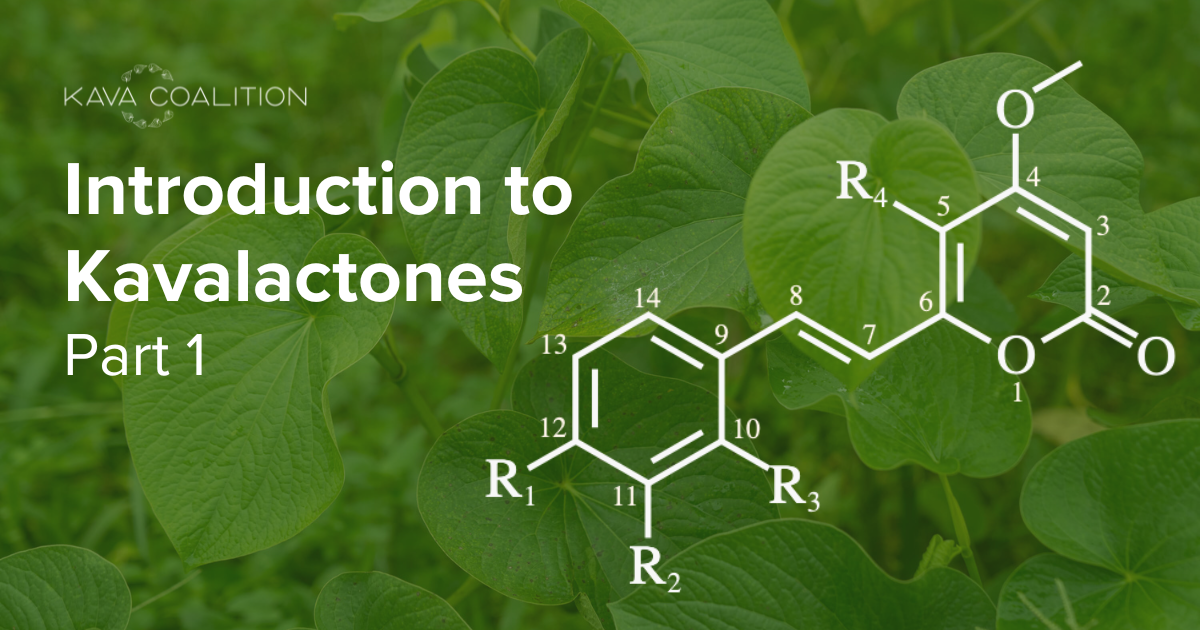Introduction to Kavalactones: Part 1
This article provides an examination of the scientific literature concerning kava and kavalactones. It is important to note that this article is not intended to serve as an endorsement for diagnosing, treating, preventing, or curing any disease.
In the realm of natural products, certain compounds possess intriguing properties that have captivated human curiosity for centuries. Among these are kavalactones, found within the roots of the kava plant (Piper methysticum). With a history steeped in tradition and a reputation for promoting relaxation and tranquility, kavalactones offer a fascinating glimpse into the therapeutic potential of botanical compounds. In this blog post, we will introduce and begin to understand kavalactones, exploring their origins, potential benefits, and safety considerations.
The story of kavalactones begins in the South Pacific islands, where the kava plant has been cultivated and revered for generations¹. Traditionally used in ceremonial rituals and social gatherings, kava has long been cherished for its ability to promote a sense of calmness and well-being. The key to kava's soothing effects is thought to lie in its bioactive constituents, particularly the kavalactones found in its roots.
Kavalactones are a diverse group of compounds with unique chemical structures characterized by a lactone ring. Many different kavalactones have been identified in the kava plant, but the six primary ones that are primarily focused on because they are found in the highest abundance in the roots are kavain, dihydrokavain, methysticin, dihydromethysticin, yangonin, and desmethoxyyangonin¹. These compounds are extracted from the roots of the kava plant and are known for their pharmacological effects on the central nervous system.
The consumption of kavalactones from different kava preparations has been associated with a range of psychoactive effects, including relaxation, reduced occasional stress, and enhanced sociability ² ³. Traditionally consumed in the South Pacific islands as a ceremonial beverage, kava has played and continues to play a central role in the cultural practices of Pacific Island communities. In addition to its ceremonial use, kava is also used in the South Pacific islands at social gatherings. Beyond its cultural and social significance, kava has garnered attention for its potential general wellness benefits. Studies suggest that kavalactones may offer relief from symptoms of occasional anxiety and stress, making them a natural alternative for those choosing to make choices about their own health.
While kavalactones hold promise as natural remedies for relaxation and occasional stress relief, questions have been raised regarding their safety profile⁵. Reports of liver toxicity associated with the consumption of kava products led to regulatory restrictions in some regions in the early 2000s, but these reports have been refuted in the years since. Yet, it is [EB¹] important for consumers to be aware of the potential risks and to exercise caution when using kava supplements if they have any preexisting conditions or take other supplements, over-the-counter, or prescription drugs. Consulting with a healthcare professional before incorporating kavalactones into one's wellness regimen is advisable, especially for individuals with pre-existing conditions or those taking medications.
Interest in kavalactones continues to grow, driven by a desire for natural alternatives. Research efforts are focused on elucidating the mechanisms of action of kavalactones, optimizing kava preparation methods to minimize the risk of adverse effects, and exploring their potential applications⁶. As scientific understanding of kavalactones deepens, there is hope these compounds may offer novel solutions for managing occasional stress and anxiety.
In closing, kavalactones represent a fascinating intersection of tradition and modern science, offering a glimpse into the potential of botanical compounds. While questions remain about them, the allure of kavalactones continues to inspire researchers and wellness enthusiasts alike. As we continue to explore the enigmatic world of kavalactones, it is clear that nature holds many secrets waiting to be unlocked. Kavalactones represent a fascinating class of natural compounds. Further research is needed to understand the properties of kavalactones fully and to ensure their efficient use.
References:
1. Lebot, V., Levesque, J., & Cabalion, P. (1997). Kava: The Pacific Elixir: The Definitive Guide to Its Ethnobotany, History, and Chemistry. Inner Traditions/Bear & Co.
2. Pittler, M. H., & Ernst, E. (2003). Kava Extract for Treating Anxiety. Cochrane Database of Systematic Reviews, 2003(1), CD003383.
3. Singh, Y. N. (1992). Kava: An Overview. Journal of Ethnopharmacology, 37(1), 13–45.
4. Mathews, J. D., Riley, M. D., Fejo, L., & Munoz, E. (1998). Effects of the heavy usage of kava on physical health: Summary of a pilot survey in an Aboriginal community. The Medical Journal of Australia, 168(7), 335–338.
5. Teschke, R., & Genthner, A. (2009). Kava hepatotoxicity: A clinical survey and critical analysis of 26 suspected cases. European Journal of Gastroenterology & Hepatology, 21(10), 1175–1183.
6. White, C. M., & Song, J. (2020). Herbal Medicines for Anxiety and Depression: An Update of Some Recent Clinical Trials. Current Psychiatry Reports, 22(8), 1–8.
EB1. Kava Consumption and Liver Heath https://www.kavacoalition.org/blog/kava-consumption-liver-health


